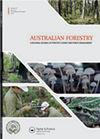宁夏中部干旱区油松林的空间分布特征
IF 1.2
4区 农林科学
Q3 FORESTRY
引用次数: 0
摘要
摘要油松(pinus tabuliformis)是宁夏罗山国家级自然保护区的造林树种,具有重要的生态价值。了解其空间分布对生态系统的管理和保护具有重要意义。本文采用空间点格局法分析了2037株活死松幼苗、幼树和大树的空间更新格局,研究了幼苗/幼树和大树分布的相关性。结果表明:油油杉乔木大小变化适中;青壮年活株比例为82%,中年活株比例为97%,高龄活株比例为100%,表明青壮年对环境的适应能力日益增强;油松种群的点格局总体上是随机分布的,但幼苗和幼树在较小的空间尺度上表现为聚集性;3个龄期(1、幼苗;二、幼树;III、枯树);总的来说,死植物和活植物之间没有空间相关性。在0 ~ 1.9 m的空间尺度上,死龄ⅰ类植物与活龄ⅱ类植物的空间相关性为正。宁夏中部干旱区油油树种群受种内竞争和有限资源空间的影响。长成大树的幼苗数量很少,森林上层冠层对空间的竞争影响了幼苗和幼树的更新。这些发现被用来提出两种油棕森林管理干预措施。关键词:罗山国家级自然保护区油松空间点格局分析空间相关性披露声明作者未发现潜在利益冲突。宁夏重点科研项目:罗山国家级自然保护区生态恢复与功能增强关键技术研究与示范[2021BEG02009]。本文章由计算机程序翻译,如有差异,请以英文原文为准。
Spatial distribution characteristics of a Pinus tabuliformis forest in the central dry zone of Ningxia, China
ABSTRACTPinus tabuliformis is a forest-building species in the Luoshan National Nature Reserve, Ningxia, China, and has crucial ecological value. Understanding its spatial distribution can play an important role in ecosystem management and conservation. Here, the spatial point pattern method was used to analyse the spatial renewal pattern of 2037 living and dead pine seedlings, young trees and large trees and to study the correlation between the distribution of seedlings/young trees and large trees. The results showed that: the P. tabuliformis trees varied moderately in size; the proportion of live plants was 82% in the youngest age class, 97% in the middle age class and 100% in the oldest age class, indicated a growing adaptation to environment; the point pattern of the P. tabuliformis population was generally randomly distributed but showed aggregation at smaller spatial scales for seedlings and young trees; there was no spatial correlation between surviving and dead plants and a weak positive correlation to no correlation among surviving plants of the three age classes (I, seedlings; II, young trees; III, dead trees); and, in general, there was no spatial correlation between dead and live plants. The spatial correlation between dead age-class I plants and living age-class II plants was positive at the spatial scales of 0–1.9 m. The P. tabuliformis population was affected by intraspecies competition and limited resources and space in the central dry zone of Ningxia. The number of seedlings growing into large trees is very small, and the competition for space in the upper canopy of the forest affects the renewal of seedlings and young trees. These findings are used to propose two management interventions for P. tabuliformis forests.KEYWORDS: Luoshan National Nature ReservePinus tabuliformisspatial point pattern analysisspatial correlation Disclosure statementNo potential conflict of interest was reported by the author(s).Additional informationFundingFunded by the Ningxia Key R&D Project: Key Technology Research and Demonstration of Ecological Restoration and Function Enhancement in Luoshan National Nature Reserve [2021BEG02009].
求助全文
通过发布文献求助,成功后即可免费获取论文全文。
去求助
来源期刊

Australian Forestry
FORESTRY-
CiteScore
3.70
自引率
4.80%
发文量
15
审稿时长
>12 weeks
期刊介绍:
Australian Forestry is published by Taylor & Francis for the Institute of Foresters of Australia (IFA) for scientific, technical, and professional communication relating to forestry in the Asia Pacific.
 求助内容:
求助内容: 应助结果提醒方式:
应助结果提醒方式:


